| From
Mesopotamian clay tablets dating back almost five thousand years,
through the classical Greek and Roman writers, to the Bible, then
by way of Shakespeare, down to the great writers and artists of our
time, wine has been a potent source of inspiration.
This theme
takes a humorous look at some of the creative literature surrounding
wine drinking with a selection of cartoons (including 12 especially
commissioned for the State Library), stories, verse and songs, from
the solemnity of the Bible and the wit of Shakespeare, to the bawdiness
of the eighteenth century, to nineteenth century books for children,
and the traditions of today.
Wine,
the most delightful of drinks, whether
we owe it to Noah,
who planted the vine, or to Bacchus, who pressed juice from the
grape, goes back to the childhood of the world.
Jean Anthelme Brillat-Savarin, The physiology of taste
Ancient
times
According
to Persian mythology, wine was discovered
by a woman. She drank the fermented juice
from grapes stored in a jar, went to sleep,
and surprisingly woke up cured of a headache,
instead of suffering from the world's first
hangover as one might have expected.
Wine became
the drink of the gods, whether they were
Egyptian, Sumerian, or Greek, and the early
deities of wine were often women, since
they were also associated with fertility.
The symbolism of wine, as well as its effect,
became potent as it was adopted into religious
ritual.

The modern
Egyptian papyrus illustrated here reproduces
ancient Egyptian winemaking techniques,
and was a recent donation to the Library.
Another
source of potent images, the sea, which was
crucial to early transport and communication,
was given the feminine gender by the Greeks.
When the ancient Greek poet Homer sang of "the
wine-dark sea" he was linking two forces
central in Mediterranean life to create an
image which continues to have great emotive
power.
In
the musical comedy Roman Scandals, produced
in 1933, Eddie Cantor finds himself in Imperial
Rome where he is employed as the food taster
for the evil emperor Valerius (Edward Arnold).
Could the last glass of the emperor's favourite
wine have been poisoned by his wife Agrippa?
Eddie is just about to find out!
The
Bible
The
Bible has many references to the vine and
wine. The first recorded mention is in Genesis,
in the ninth chapter, where we learn that
Noah planted a vineyard, and that "he drank
of the wine and was drunken". This incident
was sometimes featured in illustrated versions
of the Bible, including an English manuscript
of around 1320 known as the Holkham Bible.
The State Library's facsimile edition of
this manuscript, published in 1954, shows
Noah and his sons harvesting grapes, followed
by a vivid portrayal of the first recorded
drunkard.
The
Book of Proverbs has several things to say
on the subject of wine:
Proverbs:
Wine is a mocker
Look
not upon the wine when it is red
Forsake
not on old friend
Wine
is as good as a life to a man
Neither
do men put old wine into new bottles
Drink
no longer water
Hans Sachs
Die
vier Wunderberlichen Eygenschafft und Würckung des
Weins…,
by Hans Sachs. Nuremberg : Georg Merckel, 1553.
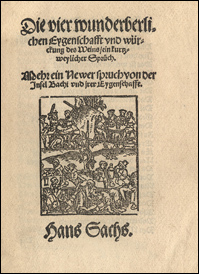 This
very scarce pamphlet describes 'the four
wondrous properties of wine and their effects'.
The opening paragraph, here translated by
Professor Ralph Elliott, gives an indication
of the tenor of this entertaining work: This
very scarce pamphlet describes 'the four
wondrous properties of wine and their effects'.
The opening paragraph, here translated by
Professor Ralph Elliott, gives an indication
of the tenor of this entertaining work:
One
day I asked a doctor to tell me whence
derives the power of wine to affect in
four different ways whomever it overcomes
so that his mood changes. The first he
makes peaceful, benevolent, mild and kind.
Others he arouses to anger, so that they
storm and quarrel and rage. The third he
makes crudely childish and shameless, while
the fourth is led by the wine to fantasies
and follies.
He
said, I will tell you. The wise pagans
describe how after the Flood had passed,
Lord Noah began to plant vines before anything
else. But the soil was unfruitful, so old
Noah cleverly fertilized it with manure
which he took from different animals, namely
sheep, bears, pigs, and monkeys. With this
he manured his vineyard all over, and when
the wine was ready it had acquired the
natures of the four animals, properties
which it still possesses. Now God made
all men of four elements, air, fire, water,
and earth, as Philosophy confirms, and
according to each man's nature, so does
wine affect him.
Hans
Sachs, who died in Nuremberg in 1576, was
a member of the Meistersinger Guild there,
and the subject of Wagner's opera, The Mastersingers
of Nuremberg.
Shakespeare
 The
works of William Shakespeare contain many
references to wine and drinking. The first
two come from the Norton facsimile edition
of The first folio of Shakespeare,
prepared by Charlton Hinman and published
in 1968. The
works of William Shakespeare contain many
references to wine and drinking. The first
two come from the Norton facsimile edition
of The first folio of Shakespeare,
prepared by Charlton Hinman and published
in 1968.
"Can
a weake emptie Vessell beare such a huge
full Hogs-head?" Doll Tearsheet in 2
Henry IV Act II Scene IV
"A
good Sherris-Sack hath a two-fold operation
in it: it ascends me into the Braine,
Dryes me there, all the foolish, and dull,
and cruddie Vapours, which environ it:
makes it apprehensive, quicke, forgetive,
full of nimble, fierie, and delectable
shapes; which deliver’d o’er
to the Voyce, the Tongue, which is the
Birth, becomes excellent Wit." Falstaff
in 2 Henry IV Act II Scene III
"Give
me a bowl of wine. In this I bury all unkindness,
Cassius." Brutus from Julius Caesar Act
IV Scene III.
"But
in faith you have drunk too much canaries, and
that’s a marvellous searching wine,
and it perfumes the blood ere one can say, ‘What’s
this’?" Mistress Quickly in 2
Henry IV Act II Scene IV
"[Drink]:
it provokes the desire, but it takes away
the performance." Porter in Macbeth Act
II Scene III
"…good
wine is a good familiar creature if it
is well used." Iago in Othello Act
II Scene III
Songs
and verse
The classic
verse from Omar Khayyam, "…A
flask of wine, a book of verse – and
thou".
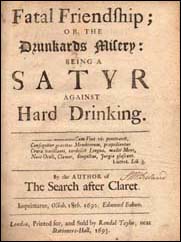 In
the 1690s Richard Ames wrote several
books of satirical verse about wine. .
Fatal friendship; or, the drunkards misery is
an early tirade against the drinking of
spirits: In
the 1690s Richard Ames wrote several
books of satirical verse about wine. .
Fatal friendship; or, the drunkards misery is
an early tirade against the drinking of
spirits:
"There are some
few of that most mighty Train,
Of his hard Drinking, brings on
wretched Man;
Yet in the Cafe it is but plain
and clear,
The Body is the smallest sufferer:
Too often the Estate the Damage
feels,
And a House totters while its
Master reels"
Henry Aldrich
gives us five reasons why we should drink:
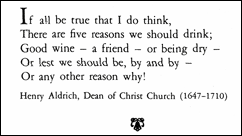
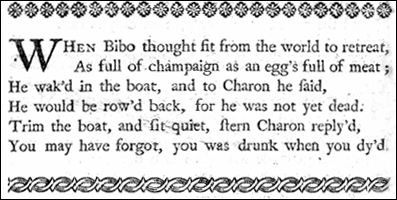
The anonymous
compiler of the 1775 work, The
buck’s bottle companion has
assembled a riotous collection of drinking
songs, unfortunately lacking the music.
"O, for a draught
of vintage! That hath been
 Cool’d
a long age in the deep-delved earth, Cool’d
a long age in the deep-delved earth,
Tasting of Flora and the country green,
 Dance, and Provencal song,
and sunburnt mirth! Dance, and Provencal song,
and sunburnt mirth!
O for a beaker full of the warm South,
 Full of the true, the blushful
Hippocrene, Full of the true, the blushful
Hippocrene,
  With
beaded bubbles winking at the brim, With
beaded bubbles winking at the brim,
   And
purple-stained mouth; And
purple-stained mouth;
 That
I might drink, and leave the world unseen, That
I might drink, and leave the world unseen,
  And
with thee fade away into the forest dim. And
with thee fade away into the forest dim.
John Keats. Ode
to a nightingale.
Was Keats referring
to a sparkling red when he wrote of "beaded
bubbles" and "purple-stained mouth"?
Songs
of the vine, edited
by W.G. Hutchison (1904)
includes:
"We care not
for money, for riches, for wealth;
Old sack is
our money, old sack is our health." - Thomas
Randolph
and "The
epicure", by Abraham Cowley
An unusual collection, Wine
songs and verses, by the choir
members of the Federal Viticultural Congress,
Sydney Ocober 2nd 1929, includes "Come
brothers fill your glasses".
G.K. Chesterton
adds a little morality to "The
song of right and wrong", in his Wine,
water and song.
Playing
cards
This image
of Bacchus comes from Playing cards
of various ages and countries, selected
from the Collection of Lady Charlotte Schrieber.
1892
 Quotations Quotations
The message
from Paracelsus is that there is a fine line
between wine being good or bad for us.
L’eloge
de l’Yvresse, or, The praise of drunkenness, by
Albert-Henri de Sallengre. 1714.
The further subtitle
gives the reader a vivid insight into the subject: "wherein
is authentically, and most evidently proved, the
necessity of frequently getting drunk, and that
the practice of getting drunk is most ancient,
primitive, and catholic".
The
Fireside book of wine (New York : Simon
and Schuster, 1977) is a selection of work
from notable writers on their thoughts or experiences
with wine. Montaigne ends his article
on "Fastidiousness in wine" with the motto, "we
should never refuse an opportunity to drink,
and should have that desire always in our minds".
Dr
Johnson gives us
his interpretations of "in vino veritas".
Mon docteur le
vin, with text by Gaston Derys and water
colours by renowned artist Raoul Dufy from 1936
includes the following quotes:
"Wine is indispensable
for writers. "
"One of the best ways
of comparing the intellectual worth of the citizens
of different countries is to examine the lists
of winners of the Nobel Prize." – Professor
Cambiaire
And, texts in hand
, Professor Cambiaire demonstrates that they have
been awarded in the majority to the scholars or
authors who hail from countries where wine is drunk.
"If wine were to disappear
from human production, I believe it would cause
an absence, a failure in health and intellect,
a void much more terrifying than all the recesses
and the deviations for which wine is regarded as
responsible." – Charles Baudelaire
"Wine, when taken
without excess, is a tonic for the muscles and
a stimulant for the mind". – Dr Widal
Sydney
socialite, extravagant party-giver and one-time
cookery school proprietor, Sue du Val, has
been described by journalist, Daphne Guiness,
as "Australia’s answer to Jennifer Paterson
(from the television series, ‘Two Fat Ladies’)".
She died in June 2000 at the age of 83 after
a very ‘full’ life. Her experiences
are typified in these
wonderful words.
Dictionaries
Australian humourist,
Keith Dunstan, together with Jeff Hook, the cartoonist,
have produced a hilarious series of definitions
for Wine:
the wine dictionary, of which that for ‘Tanker’ is
a good example.
Winedot.
A rather curious word, now teetering on the obsolete,
is explained in various dictionaries as an Australianism
for someone who drinks too much. It transpires
that it was adapted from the name of an American
breed of fowl, the Wyandotte. These handsome
birds would no doubt not have been impressed
at their name being used in such a text.
Hugh
Johnson
Hugh
Johnson’s pop-up wine book by Hugh
Johnson with
paper design by Ron Van der Meer (London
: Pyramid Books, 1989).
Leading English wine
writer, Hugh Johnson, has produced a pop-up book
to complement his more serious writings. Here,
he is wine waiter at the dinner he would like to
have hosted. The guests are from left to right:
Ludwig van Beethoven, Sir Winston Churchill, Cleopatra,
Napoleon Bonaparte, Sir Thomas Jefferson, and an
anonymous pair of feet under the table.
Another section has
illustrations of a typical
Bordeaux chateau, here seen at different angles.
Squashed between the
entries for St Huberts and Saltram in Hugh Johnson’s
Pocket wine book is one for St
Sheila’s, a pink sweet sparkling wine
with interesting best vintages.
Cartoons & illustrations
This image
of Bacchus comes from Playing cards
of various ages and countries, selected
from the Collection of Lady Charlotte Schrieber.
1892.
Not quite cartoons,
but some charming
illustrations by Jim Bancks from a
book of Exclusive cocktails (Sydney: Usher's,
1933).
Ronald Searle,
the eminent British cartoonist, has produced a
whole book on the humour of wine. Something
in the cellar-- : Ronald Searle's wonderful world
of wine, including one on "how
to open a bottle of wine".
Punch magazine
covers a wine variety of subjects. Here
are a few related to drinking from The Punch
cartoon album : 150 years of classic cartoons.
George Aldridge has
been a freelance artist and cartoonist for nearly
30 years. His commissions have ranged from community
and industry-based issues such as failing commodity
prices in South Australia’s Riverland and
rabbit control across the nation, to designing
and installing major exhibitions in the State Library
of South Australia including "Eating out: a menu
retrospective" and "Oenography: words on wine in
the State Library". In 2000 George was a prizewinner
in the international cartoon competition in Portugal.
Since drawing these
cartoons for the State Library, George says
that his awareness of the finer points of wine
tasting has increased dramatically.
Children's
material on wine
The State Library
of South Australia's Children's Literature Research
Collection is a world-renowned collection of
children's books and other material. Some items
such as songbooks, educational material and even
picture books have images relating to wine.
In the first half
of the nineteenth century there were few subjects
that were not freely communicated to children.
Books of mathematics and alphabet books were popular
means of both education and entertainment, and
what better way to impart a great deal of information
about wine and drinking?
Marmaduke
Multiply's merry method of making minor mathematicians;
or, The multiplication table,
published by John Harris in 1816-17, celebrated
a recent victory by toasting the Hero of
Waterloo (or was it a pub?), while Merry
multiplication and Grandmamma
Easy's Alderman Feast. A
new alphabet land published in the1840s
were full of exuberance in depicting feasting
and drinking.

The
arrival of the Temperance Movement in the mid-nineteenth
century saw attitudes change. Drink was a curse,
and the downfall of many a parent was redeemed
only by the efforts of the children.
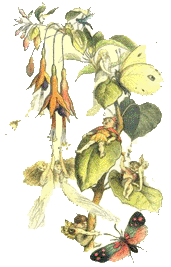 By the late nineteenth
century attitudes to drinking wines and spirits
had softened somewhat. Pan-pipes,
a book of songs, illustrated by Walter
Crane (1883) included a song about a lover pledging
his sweetheart not with wine but with a look, while
a song mimicking inebriation was among the French Vieilles
chansons pour les petits enfants, illustrated
by M.B. de Monvel. By the late nineteenth
century attitudes to drinking wines and spirits
had softened somewhat. Pan-pipes,
a book of songs, illustrated by Walter
Crane (1883) included a song about a lover pledging
his sweetheart not with wine but with a look, while
a song mimicking inebriation was among the French Vieilles
chansons pour les petits enfants, illustrated
by M.B. de Monvel.
For the very young
and romantic, fairies gather nectar and dewdrops
in their cups in a scene from In
Fairy Land (1870). Richard Doyle, the illustrator
of this work, was Sir Conan Doyle's uncle.
"Blot
out every book in which wine is praised
and you blot out the world’s great
literature, from the Bible and Shakespeare
to the latest best-seller. Blot out the
wine-drinkers of the world and you blot
out history, including saints, philosophers,
statesmen, soldiers, scientists, and
artists."
Julian Street. Table topics, 1959.
|

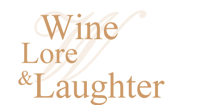
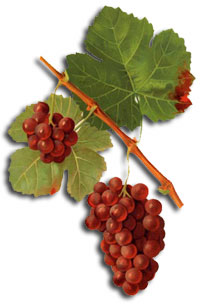

 This
very scarce pamphlet describes 'the four
wondrous properties of wine and their effects'.
The opening paragraph, here translated by
Professor Ralph Elliott, gives an indication
of the tenor of this entertaining work:
This
very scarce pamphlet describes 'the four
wondrous properties of wine and their effects'.
The opening paragraph, here translated by
Professor Ralph Elliott, gives an indication
of the tenor of this entertaining work:  The
works of William Shakespeare contain many
references to wine and drinking. The first
two come from the Norton facsimile edition
of The first folio of Shakespeare,
prepared by Charlton Hinman and published
in 1968.
The
works of William Shakespeare contain many
references to wine and drinking. The first
two come from the Norton facsimile edition
of The first folio of Shakespeare,
prepared by Charlton Hinman and published
in 1968. In
the 1690s Richard Ames wrote several
books of satirical verse about wine. .
Fatal friendship; or, the drunkards misery is
an early tirade against the drinking of
spirits:
In
the 1690s Richard Ames wrote several
books of satirical verse about wine. .
Fatal friendship; or, the drunkards misery is
an early tirade against the drinking of
spirits:




 By the late nineteenth
century attitudes to drinking wines and spirits
had softened somewhat.
By the late nineteenth
century attitudes to drinking wines and spirits
had softened somewhat.